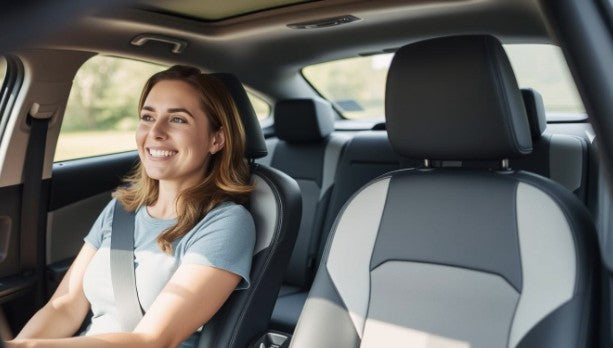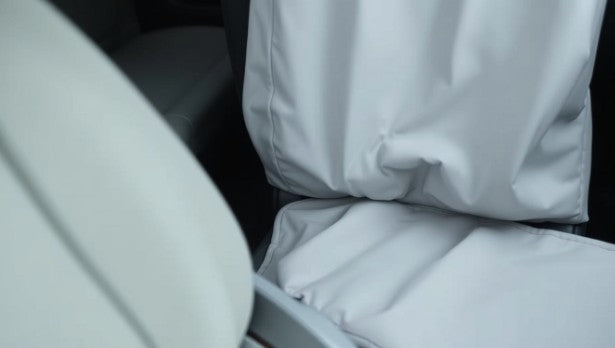Selecting the right seat covers for your vehicle involves more than just picking an attractive design or color. One of the most fundamental decisions you'll face is choosing between low back and high back seat covers. This choice affects not only the appearance of your vehicle's interior but also comfort, protection, and functionality. In this comprehensive guide, we'll explore the key differences between these two seat cover types and help you make an informed decision for your specific needs.
What Are Low Back and High Back Seat Covers?
Before diving into comparisons, let's clearly define what low back and high back seat covers actually are:
Low Back Seat Covers
Low back seat covers are designed for seats with adjustable, detachable headrests. These covers typically extend from the bottom of the seat up to just below the headrest, leaving the headrest uncovered. The headrest must be removed during installation and then reattached after the cover is in place. Many low back covers include separate matching headrest covers as optional accessories.
High Back Seat Covers
High back seat covers are designed for seats with integrated, non-removable headrests (sometimes called "highback buckets"). These covers extend in one continuous piece from the bottom of the seat all the way up and over the built-in headrest. They provide complete coverage of the entire seat in a single unit, without any separation between the seat back and headrest portions.
Coverage Area Comparison: Low Back vs High Back
Understanding the coverage differences between these two seat cover types is essential for making the right choice for your vehicle:
Low Back Coverage
- Neck/Head Support: Requires separate headrest covers or leaves headrests uncovered
- Lumbar Coverage: Covers the lower back area but stops before reaching the headrest
- Seat Anchoring: Typically uses elastic straps, hooks, or ties that secure under the seat
- Installation: Requires removal of headrests during installation
- Compatibility: Works with seats featuring adjustable, detachable headrests
High Back Coverage
- Neck/Head Support: Complete coverage including the integrated headrest
- Lumbar Coverage: Full coverage from seat bottom to top of headrest in one piece
- Seat Anchoring: Uses elastic straps, hooks, or ties plus additional securing points at the top
- Installation: No headrest removal needed
- Compatibility: Designed for seats with built-in, non-removable headrests
Benefits and Drawbacks: Pros and Cons Comparison
Each seat cover type offers distinct advantages and disadvantages that should be considered based on your specific needs:
Low Back Seat Cover Pros
- More universal fit across different vehicle models
- Easier to install and remove
- Often less expensive than high back options
- Better airflow around headrest area
- Allows for headrest adjustment without restriction
- Easier to clean individually
Low Back Seat Cover Cons
- Incomplete coverage if headrest covers aren't purchased
- May shift or bunch up more easily
- Potential color mismatch between seat and headrest covers
- Less protection for the entire seat
- Headrest covers can slip off with frequent adjustment
High Back Seat Cover Pros
- Complete, seamless coverage of the entire seat
- Better protection against spills, dirt, and wear
- More secure fit with less shifting
- Consistent appearance with no gaps
- No separate pieces to keep track of
- Often more durable construction
High Back Seat Cover Cons
- Generally more expensive than low back options
- More challenging to install correctly
- Less universal; must match specific seat configurations
- May restrict headrest functionality in some cases
- More difficult to clean as a single unit
Best Use Cases: When to Choose Each Type
Different vehicles and usage scenarios call for specific seat cover types. Here's when to choose each option:
|
Recommended For |
Low Back Seat Covers |
High Back Seat Covers |
|
Vehicle Types |
Sports cars, compact vehicles, older models with adjustable headrests |
SUVs, trucks, family vehicles with integrated headrests |
|
Seasonal Use |
Summer (better ventilation, cooler) |
Winter (better insulation, warmer) |
|
Usage Pattern |
Occasional use, temporary protection |
Daily drivers, long-term protection |
|
Passengers |
Adult passengers who adjust headrests frequently |
Families with children, pet owners (more complete protection) |
|
Budget |
Cost-conscious buyers |
Those prioritizing quality and complete protection |
Find the Perfect Seat Covers for Your Vehicle
Not sure which type fits your seats? Most quality seat cover manufacturers offer vehicle-specific options that take the guesswork out of choosing between low back and high back covers.
Material Considerations for Different Seat Cover Types
The material of your seat covers significantly impacts both functionality and comfort. Here's how different materials work with low back and high back seat cover designs:
Neoprene
Low Back: Excellent for sporty vehicles, provides good grip and prevents sliding. Separate headrest covers maintain ventilation.
High Back: Creates a waterproof seal across the entire seat, ideal for outdoor enthusiasts and pet owners. May cause heat buildup in warmer climates.
Leather/Leatherette
Low Back: Provides a luxury look while allowing original headrests to show. Easier to clean in separate pieces.
High Back: Creates a complete luxury makeover with seamless appearance. Better protection but requires more maintenance to prevent cracking at flex points.
Canvas/Ballistic Fabric
Low Back: Ideal for work vehicles, allows flexibility and movement. Breathable with good durability for frequent entry/exit.
High Back: Maximum protection for trucks and commercial vehicles. Heavier material provides complete coverage but may be bulkier to install.
When selecting materials, consider your climate, usage patterns, and cleaning preferences. For example, in hot climates, breathable fabrics work better with low back designs to allow air circulation, while in colder regions, the complete coverage of high back covers in insulating materials provides more comfort.
Buying Guide: 5 Essential Questions Before Purchasing
Before making your final decision between low back and high back seat covers, ask yourself these critical questions:
1. What type of headrests do your seats have?
Examine your seats carefully. If your headrests are adjustable and can be removed by pressing buttons at their base, you likely need low back covers with separate headrest covers. If your headrests are built into the seat as one continuous piece, high back covers are required.
Pro Tip: Take photos of your seats from multiple angles before shopping to ensure you select the correct type.
2. Do you need child seat anchors or airbag compatibility?
If you use child safety seats that connect to anchors in your vehicle's seats, ensure your seat covers have openings for these connections. Similarly, if your seats have side airbags, you need covers specifically designed with airbag compatibility.
Safety Note: Never compromise on airbag functionality. High back covers must have special stitching that allows airbags to deploy properly.
3. What's your primary purpose for seat covers?
If you're primarily concerned with protection from spills, pet hair, or children's messes, high back covers offer more complete protection. If you're more focused on refreshing your interior's appearance or providing basic protection while maintaining original comfort features, low back covers might be sufficient.
4. What's your climate and typical usage?
In hot climates, low back covers may provide better ventilation. For cold climates, high back covers offer more complete insulation. Consider how you use your vehicle—work trucks and family vehicles with frequent messes benefit from the complete coverage of high back designs.
5. Are you looking for universal fit or custom-made?
Universal low back covers tend to fit a wider range of vehicles but may not provide as precise a fit. Custom-made covers—whether low or high back—will offer the best fit for your specific vehicle model but at a higher price point.
Value Tip: Custom-fit high back covers typically provide the best long-term value despite higher initial cost.
Ready to Protect Your Vehicle's Interior?
Now that you understand the differences between low back and high back seat covers, it's time to find the perfect match for your vehicle.
Installation Tips for Both Seat Cover Types
Proper installation ensures your seat covers fit correctly and provide maximum protection. Here are some helpful tips for installing both low back and high back seat covers:
Low Back Installation Tips
- Remove headrests completely before installation
- Slide cover over seat back, ensuring it's centered
- Pull cover down firmly to remove wrinkles
- Secure bottom straps under seat
- Reattach headrests through designated openings
- Install separate headrest covers if included
High Back Installation Tips
- Push seat forward to access back completely
- Slide cover from top to bottom in one motion
- Work material around integrated headrest carefully
- Pull down firmly to remove wrinkles
- Secure all straps and hooks underneath
- Check for airbag indicators and ensure they align
Final Thoughts: Making Your Decision
Choosing between low back and high back seat covers ultimately comes down to your specific vehicle configuration, personal preferences, and protection needs. Low back covers offer versatility, easier installation, and often lower costs, making them ideal for vehicles with removable headrests and drivers seeking basic protection. High back covers provide complete, seamless protection and a unified appearance, perfect for integrated-headrest seats and those wanting maximum coverage.
Remember that quality matters regardless of which type you choose. Well-made seat covers of either style will outlast cheaper alternatives and provide better protection for your vehicle's original upholstery. Consider your vehicle's specific seat design, your typical usage patterns, and your aesthetic preferences when making your final decision.
Remember: Always verify your vehicle's exact seat configuration before ordering. When in doubt, contact the manufacturer with photos of your seats to ensure you get the correct type of seat covers for your specific needs.
Protect Your Investment Today
Quality seat covers extend the life of your vehicle's interior and maintain its resale value. Whether you choose low back or high back designs, the right seat covers are an investment that pays off.




Leave a comment
This site is protected by hCaptcha and the hCaptcha Privacy Policy and Terms of Service apply.